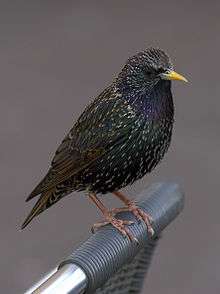Neoaves
| Neoavians Temporal range: Late Cretaceous – Holocene, 75–0 Ma | |
|---|---|
 | |
| Common starling (Sturnus vulgaris) | |
| Scientific classification | |
| Kingdom: | Animalia |
| Phylum: | Chordata |
| Class: | Aves |
| Infraclass: | Neognathae |
| Superorder: | Neoaves Sibley et al., 1988 |
| Clades | |
Neoaves is a clade that consists of all modern birds (Neornithes or Aves) with the exception of Paleognathae (ratites and kin) and Galloanserae (ducks, chickens and kin). The early diversification of the various neoavian groups occurred very rapidly, and attempts to resolve their relationships with each other have resulted initially in much controversy.[2][3]
One hypothesis of the cladogram of modern birds relationships based on Jarvis, E.D. et al. (2014)[4] with some clade names after Yury, T. et al. (2013).[5]
| Neoaves |
| ||||||||||||||||||||||||||||||||||||||||||||||||||||||||||||||||||||||||||||||||||||||||||||||||||||||||||||||||||||||||||||||||||||||||||||||||||||||||||||
| |
The other hypothesis of the cladogram of modern birds relationships based on Prum et al. (2015).[6]
| Neoaves |
| ||||||||||||||||||||||||||||||
| |
References
- ↑ Van Tuinen M. (2009) Birds (Aves). In The Timetree of Life, Hedges SB, Kumar S (eds). Oxford: Oxford University Press; 409–411.
- ↑ Mayr G. (2011) Metaves, Mirandornithes, Strisores and other novelties - a critical review of the higher-level phylogeny of neornithine birds. J Zool Syst Evol Res. 49:58-76.
- ↑ Matzke, A. et al. (2012) Retroposon insertion patterns of neoavian birds: strong evidence for an extensive incomplete lineage sorting era Mol. Biol. Evol.
- ↑ Jarvis, E.D. et al. (2014) Whole-genome analyses resolve early branches in the tree of life of modern birds. Science, 346(6215):1320-1331.
- ↑ Yuri, T. et al. (2013) Parsimony and Model-Based Analyses of Indels in Avian Nuclear Genes Reveal Congruent and Incongruent Phylogenetic Signals. Biology, 2(1):419-444. doi:10.3390/biology2010419
- ↑ Prum, R. O. et al. A comprehensive phylogeny of birds (Aves) using targeted next-generation DNA sequencing. Nature (2015). doi:10.1038/nature15697



_white_background.jpg)

_white_background.jpg)